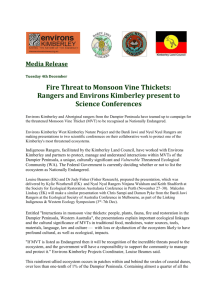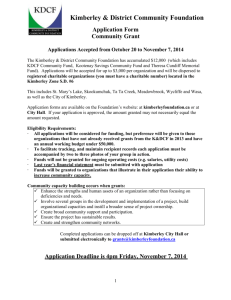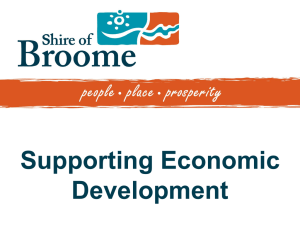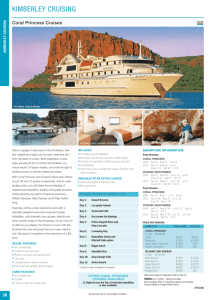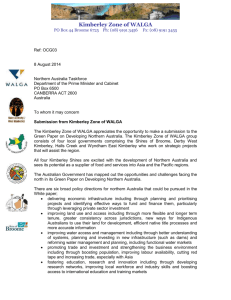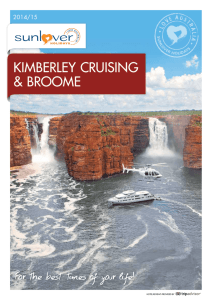MEDIA RELEASE Valuable & Threatened Broome Botanical Society
advertisement
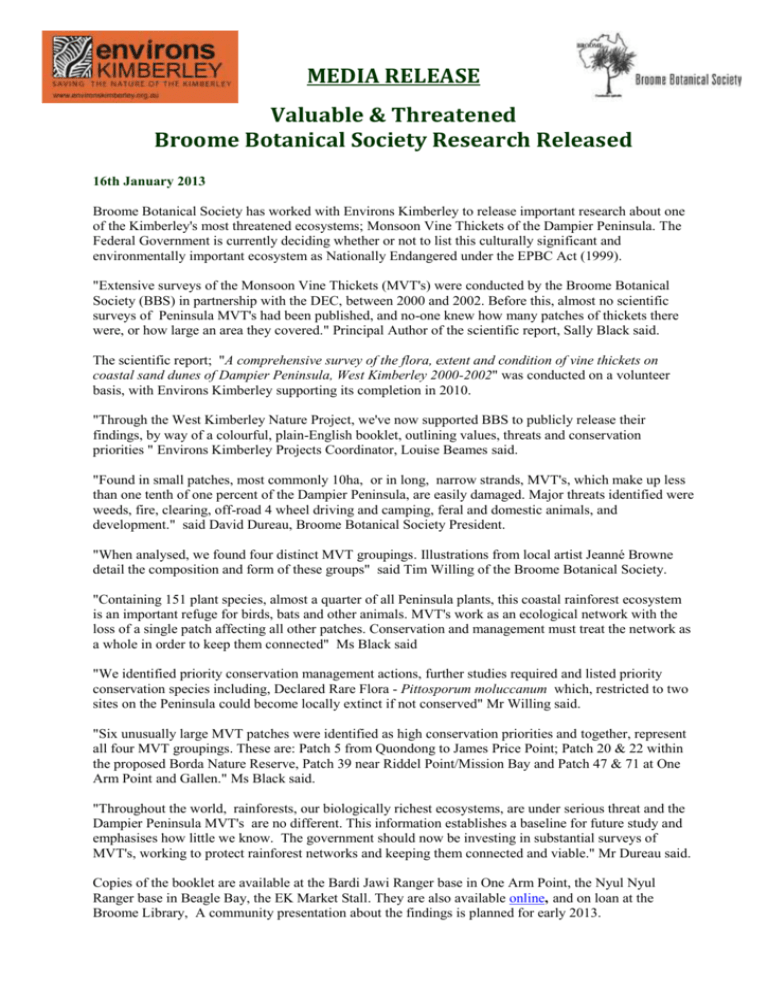
MEDIA RELEASE Valuable & Threatened Broome Botanical Society Research Released 16th January 2013 Broome Botanical Society has worked with Environs Kimberley to release important research about one of the Kimberley's most threatened ecosystems; Monsoon Vine Thickets of the Dampier Peninsula. The Federal Government is currently deciding whether or not to list this culturally significant and environmentally important ecosystem as Nationally Endangered under the EPBC Act (1999). "Extensive surveys of the Monsoon Vine Thickets (MVT's) were conducted by the Broome Botanical Society (BBS) in partnership with the DEC, between 2000 and 2002. Before this, almost no scientific surveys of Peninsula MVT's had been published, and no-one knew how many patches of thickets there were, or how large an area they covered." Principal Author of the scientific report, Sally Black said. The scientific report; "A comprehensive survey of the flora, extent and condition of vine thickets on coastal sand dunes of Dampier Peninsula, West Kimberley 2000-2002" was conducted on a volunteer basis, with Environs Kimberley supporting its completion in 2010. "Through the West Kimberley Nature Project, we've now supported BBS to publicly release their findings, by way of a colourful, plain-English booklet, outlining values, threats and conservation priorities " Environs Kimberley Projects Coordinator, Louise Beames said. "Found in small patches, most commonly 10ha, or in long, narrow strands, MVT's, which make up less than one tenth of one percent of the Dampier Peninsula, are easily damaged. Major threats identified were weeds, fire, clearing, off-road 4 wheel driving and camping, feral and domestic animals, and development." said David Dureau, Broome Botanical Society President. "When analysed, we found four distinct MVT groupings. Illustrations from local artist Jeanné Browne detail the composition and form of these groups" said Tim Willing of the Broome Botanical Society. "Containing 151 plant species, almost a quarter of all Peninsula plants, this coastal rainforest ecosystem is an important refuge for birds, bats and other animals. MVT's work as an ecological network with the loss of a single patch affecting all other patches. Conservation and management must treat the network as a whole in order to keep them connected" Ms Black said "We identified priority conservation management actions, further studies required and listed priority conservation species including, Declared Rare Flora - Pittosporum moluccanum which, restricted to two sites on the Peninsula could become locally extinct if not conserved" Mr Willing said. "Six unusually large MVT patches were identified as high conservation priorities and together, represent all four MVT groupings. These are: Patch 5 from Quondong to James Price Point; Patch 20 & 22 within the proposed Borda Nature Reserve, Patch 39 near Riddel Point/Mission Bay and Patch 47 & 71 at One Arm Point and Gallen." Ms Black said. "Throughout the world, rainforests, our biologically richest ecosystems, are under serious threat and the Dampier Peninsula MVT's are no different. This information establishes a baseline for future study and emphasises how little we know. The government should now be investing in substantial surveys of MVT's, working to protect rainforest networks and keeping them connected and viable." Mr Dureau said. Copies of the booklet are available at the Bardi Jawi Ranger base in One Arm Point, the Nyul Nyul Ranger base in Beagle Bay, the EK Market Stall. They are also available online, and on loan at the Broome Library, A community presentation about the findings is planned for early 2013. MEDIA RELEASE Who are we? The Broome Botanical Society's: Sally Black, Tim Willing and David Dureau conducted the initial surveys in partnership with the Department of Environment and Conservation. Much of the work was unfunded and conducted on a voluntary basis by Broome Botanical Society. WATSCU was funded at the time by NHT to do some aligned and collaborative work. The West Kimberley Nature Project (WKNP) is run by ecologist Louise Beames at Environs Kimberley and funded by Rangelands NRM WA through the Caring for our Country and supported through The State NRM WA. Compilation and writing of the full scientific report was completed mostly on a volunteer basis by principle author Sally Black. The Environs Kimberley WKNP supported Sally and the BBS to finalise the full scientific report in 2010. The plain-English publication "Valuable & Threatened" has been compiled by Louise Beames and Emma Bellfield (Environs Kimberley) with the assistance of Sally Black. Contacts: Louise Beames Projects Coordinator Environs Kimberley Ph: 0448472005 Louise.natureproject@environskimberley.org.au David Dureau President Broome Botanical Society Phone: (03) 98261696 Sally Black Broome Botanical Society 0427 889 635 blacksally@mail.com Tim Willing Broome Botanical Society 045 8739 261 tim@fairtel.com.au
